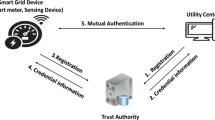Abstract
Mobile ad hoc networks (MANETs) are qualified by multi-hop wireless links and resource restrained nodes. Generally, mobile ad hoc networks (MANETs) are susceptible to various attacks like gray hole attack, black hole attack, selective packet dropping attack, Sybil attack, and flooding attack. Therefore, the wireless network should be protected using encryption, firewalls, detection schemes to identify the attackers and decreasing their impact on the network. So, it’s an essential task to design the intelligent intrusion detection system. This research work deals with designing the multilevel trust based intelligence intrusion detection system with cryptography schemes for detecting the attackers. In order to identify the attackers, we propose a novel trust management with elliptic curve cryptography (ECC) algorithm. At first, a trust manager is maintained, its functions is to classify the trust into three different sets of trust level based upon the elliptic curve cryptography and Schnorr’s signature in the MANET. Each trust level has identified a single attacker. Thus, the proposed method has detected three types of attackers such as black hole attack, flooding attack and selective packet dropping attack. Furthermore, it have provided countermeasure for these attackers in the MANET as well as improved performances. Hence, it obtains higher throughput, minimum delay, minimum packet loss and efficient end to end delivery in MANET. Thus, the proposed scheme is a secure and optimal solution to encounter attackers, which represents to be efficient and significant.










Similar content being viewed by others
References
Siva Ram Murthy, C., Manoj, B.S.: Ad Hoc Wireless Networks, Architecture, and Protocols. Prentice Hall PTR, Upper Saddle River (2004)
Basagni, S., Conti, M., Giordano, S., Stojmenovic, I.: Mobile Ad Hoc Networks. IEEE Press, Wiley (2003)
Aggelou, G., et al.: Mobile Ad Hoc Networks, 2nd edn. McGraw Hill Professional Engineering, Oxford (2004)
Chlamtac, I., Conti, M., Liu, J.J.-N.: Mobile ad hoc networking: imperatives and challenges. Elsevier Netw. Mag. 13, 13–64 (2004)
Belding-Royer, E.M., Toh, C.K.: A review of current routing protocols for ad-hoc mobile wireless networks. IEEE Pers. Commun. Mag. 6(2), 46–55 (1999)
Banerjee, S.: Detection/removal of cooperative black and gray hole attack in mobile ad-hoc networks. In: Proceedings of the World Congress on Engineering and Computer Science (2008)
Jain, S., Jain, M., Kandwal, H.: Advanced algorithm for detection and prevention of cooperative black and gray hole attacks in mobile ad hoc networks. J. Comput. Appl. 1(7), 37–42 (2010)
Agrawal, P., Ghosh, R.K., Das, S.K.: Cooperative black and gray hole attacks in mobile ad hoc networks. In: Proceedings of the 2nd International Conference on Ubiquitous Information Management and Communication, pp. 310–314. Suwon, Korea (2008)
Baadache, A., Belmehdi, A.: Avoiding black hole and cooperative black hole attacks in wireless ad hoc networks. J. Comput. Sci. Inf. Secur. 7(1), 10–16 (2010)
Bace, R., et al.: An Introduction to Intrusion Detection & Assessment. Infidel Inc., prepared for ICSA Inc. Copyright 1998 (1998)
Richard. M., et al.: Intrusion Detection FAQ: Are their limitations of Intrusion Signatures. http://www.sans.org/security-resources/idfaq/ limitations. PHP, April 5 (2001)
Kozushko, H.: Intrusion detection: host based and network-based intrusion detection systems. Indep. Study 11, 1–23 (2003)
Abraham, A., et al.: SCIDS: a soft computing intrusion detection system. In: WDC 2004. LNCS, School of Computer Science and Engineering, Chung-Ang University, Korea, Springer, Berlin, Heidelberg, vol. 3326, pp. 252–257 (2004)
Toosi, A.N., Kahani, M.: A new approach to intrusion detection based on an evolutionary soft computing model using neuro-fuzzy classifiers. Comput. Commun. 30(10), 2201–2212 (2005)
Abraham, A., Jain, R., Thomas, J., Han, S.Y.: D-SCIDS: distributed soft computing intrusion detection system. J. Netw. Comput. Appl. 30(82), 81–98 (2007)
Hubballi, N., et al.: Fuzzy mega cluster based anomaly network intrusion detection, In: International Conference on Network and Service Security, 2009. N2S ’09. ISBN: 978-2-9532-4431-1 (2009)
Wang, F., Chen, H., Zhao, J., Rong, C.: IDMTM: a novel intrusion detection mechanism based on trust model for ad hoc networks. In: 22nd International Conference on Advanced Information Networking and Applications, AINA 2008, pp. 978, 984
Gonzalez, O.F., Ansa, G., Howarth, M., Pavlou, G.: Detection and accusation of packet forwarding misbehavior in mobile ad-hoc networks. J. Internet Eng. 2(1), 181–192 (2008)
Nadeem, A., Howarth, M.: Adaptive intrusion detection & prevention of denial of service attacks in MANETs. In: ACM, 2009 (2009)
Wei, Z., et al.: Security enhancements for mobile ad hoc networks with trust management using uncertain reasoning. IEEE Trans. Veh. Technol. 63(9), 4647–4658 (2014)
Biwas, S., et al.: Trust based energy efficient detection and avoidance of black hole attack to ensure secure routing in MANET. In: Applications and Innovations in Mobile Computing (AIMoC), 2014 (2014)
Agarwal, U., Yadav, K.P., Tiwari, U.: Security threats in mobile ad hoc networks. Int. J. Res. Sci. Technol. 2(2), 53–64 (2015)
Issariyakul, T., Hossain, E.: Introduction to Network Simulator NS2. Springer, New York (2009)
Sajjad, S.M.: Neighbor node trust based intrusion detection system for WSN. In: 6th International Conference on Emerging Ubiquitous Systems and Pervasive Networks, EUSPN-2015 (2015)
Acknowledgements
Authors are highly thankful to the Department of RIC, IKG Punjab Technical University, Kapurthala, Punjab, India for providing the opportunity to conduct this research work.
Author information
Authors and Affiliations
Corresponding author
Ethics declarations
Conflict of interest
The authors declare no conflict of interest.
Rights and permissions
About this article
Cite this article
Singh, O., Singh, J. & Singh, R. Multi-level trust based intelligence intrusion detection system to detect the malicious nodes using elliptic curve cryptography in MANET. Cluster Comput 21, 51–63 (2018). https://doi.org/10.1007/s10586-017-0927-z
Received:
Revised:
Accepted:
Published:
Issue Date:
DOI: https://doi.org/10.1007/s10586-017-0927-z




